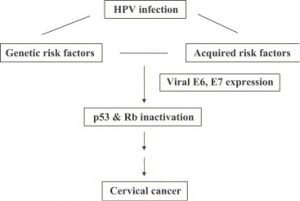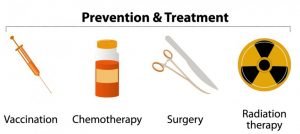“Cervical Cancer is a type of Cancer; an uncontrolled growth of cells in the body, when cells begin to divide out of control and have the ability to invade and spread to other tissues of the body.”
Cervical cancer arises in the lower part of uterus in the cells lining the cervix, also known as uterine cervix. The cervix mainly connects uterus and vagina. Cervical cells do not develop into cancer while it gradually changes from pre-cancerous changes to cancer and mainly arises in the cells of zone of transformation of endo-cervix and exo-cervix. 
Types of cervical cancer:
There are mainly two types of cervical cancer according to their visibility and shape of cells under microscope.
- Squamous cell carcinoma: 80%
Cancer develops in the cells of exocervix and transformation zone and appears as squamous cells under microscope.
- Adenocarcinoma: 15-20%
Type of cervical cancer which develops adenocarcinoma in the mucous producing glandular cells lining the endocervix
Epidemiology:
Cervical cancer is the third most common cancer in females and fourth death causing cancer in women worldwide. According to the estimation made by Cancer.net:
- 12,990 US women were diagnosed with cervical cancer, and
- 4120 deaths can be possible due to the fatal disease this year alone
Stages of Cervical Cancer:
Stages of the cancer matters a lot because it tells about the extent and type of cancer spread. Stages of cervical cancer which defines the extent of cancer are:
Stage 0 or Carcinoma in situ (CIS)
Carcinoma in situ (CIS) are some cancerous changes in cervical cells but it is not cancer. It may develop into cancer with time and can be noticed and curable as soon as possible.
Stage 1– first stage of cervical cancer when tumor has crossed the upper layer of cervix and cancer cells can be examined in cervix, while its symptoms are very hard to find.
Stage 2- tumor has extends to upper part of vagina and crossed the cervix and its surrounding tissues up to pelvic wall
Stage 3- tumor has grown towards pelvic muscles and ligaments also into the lower part of vagina and it can inhibit urine flow
Stage 4- it’s an advanced stage, cancer spreads from cervix and womb to other organs of body including rectum or bladder
Pathogenesis:
Cancer develops when there is genetic mutation occurs which leads to turn on oncogenes and turnoff tumor suppressor genes.
Human papillomaviruses (HPV) is a group of 150 related viruses and is the major cause of up to 99.7% of cervical cancers. HPV infections turn off the tumor suppressor genes by increasing the production of E6 and E7 proteins which leads to begin uncontrolled growth (papillomas) of cells lining the cervix and develops into cancer.

HPV causes infections in the cells lining the throat, mouth, anus and genitals. It can spread from one individual to other through skin to skin contact as well as via sexual activity like anal, vaginal, genital and oral sex.
HPV could be high risk when it leads to cancers including vaginal cancer, vulva, cervix in women and penile cancer in men. HPV can even cause the cancer of mouth, throat and anus in both genders.
Other Risk Factors:
There are some other factors involved in cervical cancer risk:
- Tobacco usage
- Multiple sexual partners
- Genetic factors
- Viral factors (HIV, HPV)
- High usage of oral contraceptives
- Use of intrauterine device
- Nutrient Deficiency
- Poor personal hygiene
- Low socioeconomic status
Signs and Symptoms:
Signs and symptoms help the practitioner to identify and staging the cervical cancer including:
- Pelvic pain
- Blood in urine
- Unusual vaginal discharge
- Lower back pain
- Incontinence
- Pain during sex
- Vaginal bleeding after sex
- Vaginal bleeding during periods
- Longer or heavier menstrual periods than usual
- Lower limb lymphoedema
Diagnosis
Cervical cancer can be prevented and treated if alterations and mutation in cervical cells can be identified earlier via diagnostic tests and its known signs and symptoms. These are following diagnostic tests are being used for identification of cervical cancers.
- Physical examination and medical history
- Pelvic Examination
- Pap Test
- HPV test
- Endocervical Currettage
- Colposcopy
- Biopsy
- Magnetic resonance imaging (MRI)
Treatment:
Treatment of the cervical cancer depends on type of the cancer, how far it has been spread, exact location, and level of extent, growth of cancer spot in cervix and overall health of the patient. Cervical cancer can be curable if it is diagnosed at early stages but its cure becomes difficult if cancer has progressed to areas other than cervix. There are two steps of treatment:
- Early stage cervical cancer:
For early stage cervical cancer patients’ radiotherapy or surgery is done to remove the cervix only or whole womb and sometimes combination of both being used.
- Advanced cervical cancer:
In advanced cancer mainly radiotherapy with or without chemotherapy can be done and sometimes surgery can also be performed.

Preventive Measures:
Early stage cancer can be curable via treatment but it can also be treated and prevented via taking some precautionary measures like:
- HPV vaccination
- HPV testing
- Regular screening tests
- No smoking
- Use condom
Future perspectives:
It is reported that cervical cancer is widely diagnosed disease among women but still there no effective management of the disease. For effective treatment of CC, a better understanding of etiology and risk factor requires for more development and introduction of new technological procedures for the management of disease. To evaluate the efficacy and survival rates, it requires advance studies that can help to collect accurate information about disease.
References:
American Cancer Society. Cancer Facts and Figures 2018. Atlanta, Ga: American Cancer Society; 2018.
American Joint Committee on Cancer. Cervix Uteri. In: AJCC Cancer Staging Manual. 7th ed. New York, NY: Springer; 2010:395-402.
Anderson TA, Schick V, Herbenick D, Dodge B, Fortenberry JD. A study of human papillomavirus on vaginally inserted sex toys, before and after cleaning, among women who have sex with women and men. Sex Transm Infect. 2014 Apr 16.
Bentivegna E, Maulard A, Pautier P, et al. Fertility results and pregnancy outcomes after conservative treatment of cervical cancer: A systematic review of the literature. Fertil Steril. 2016;106:1195-1211.
Chaturvedi AK, Kleinerman RA, Hildesheim A, et al. Second cancers after squamous cell carcinoma and adenocarcinoma of the cervix. J Clin Oncol. 2009;27:967-973.
Cuzick J, Myers O, Hunt WC, et al. A population-based evaluation of cervical screening in the United States: 2008-2011. Cancer Epidemiol Biomarkers Prev. 2014;23:765-73.
Jhingran A, Russel AH, Seiden MV, et al. Cancers of the cervix, vagina and vulva. In: Abeloff MD, Armitage JO, Lichter AS, et al. Clinical Oncology. 5th ed. Philadelphia, Pa; Elsevier; 2008: 1534-1574.
Lacey JV Jr, Swanson CA, Brinton LA, et al. Obesity as a potential risk factor for adenocarcinomas and squamous cell carcinomas of the uterine cervix. Cancer. 2003;98:814-821.
Li N et al., 2011. Human papillomavirus type distribution in 30,848 invasive cervical cancers worldwide: variation by geographical region, histological type and year of publication. International Journal of Cancer 128, 927–935.
Bosch FX et al., 2008. Epidemiology and natural history of human papillomavirus infections and type-specific implications in cervical neoplasia. Vaccine 26 (Suppl. 10), K1–K16.
Garces AHI, Dias MSF, Nogueira-Rodrigues A, de Toledo Lima FM, Paulino E and de Melo AC. Staging Cervical Cancer-Current and Future Perspectives. Austin J Obstet Gynecol. 2014;1(4): 4. ISSN:2378-1386
About the Authors:
Noreen Aslam1*, Dr. Muhammad Naeem Faisal1, Humaira Muzaffar1, Alishbah Roobi1
1Institute of Pharmacy, Physiology and Pharmacology, Faculty of Veterinary Science, University of Agriculture, Faisalabad, Pakistan
Corresponding author*